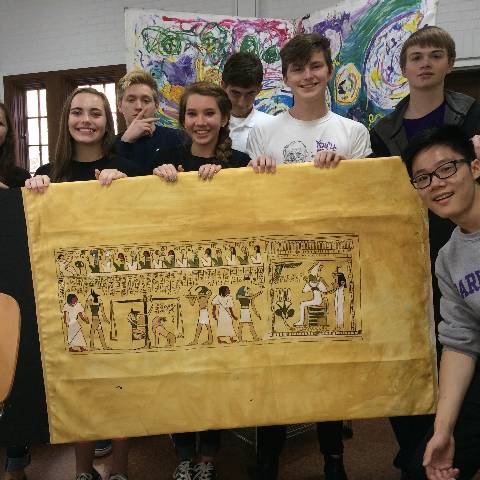When studying art of the ancient world, one is tempted to ask the same questions of these artists lost to history as one would be to more famous modern artists. What was their motivation? What message were they trying to convey? How was the message received?
Those who claim to have no artistic ability often say that they cannot draw a straight line. The natural ability to recreate what one sees has often set the visual artist apart from the rest of society. Being able to create recognizable images might have given the early artist importance or even mystical power in their tribe.
As a project, our Art History class recently recreated a cave painting on canvas. Inspired by paintings we studied in class, students painted herds of animals and hunters as well as handprints often found in caves inhabited by early humans.
After our study of Neolithic cave paintings, our class followed artists as civilization progressed and art became more formalized. One of the best examples of this formalization can be found in Ancient Egypt. One thing that did not change, however, was the fact that artists were seen as having a special skill, which elevated them in society. The Ancient Egyptians treasured artists but also limited their creativity to a formalized style that was repeated throughout Egypt for over 3,000 years.
Observing the stylized art from ancient civilizations like Egypt can tell an art historian what a society felt was important. Powerful Pharaohs created the well-known style and held all Egyptian artists to that standard. Also, the fact that much of this art is found in tombs shows that the Ancient Egyptians had a fascination with death and the afterlife. The painted adult Egyptian human figure is a standard height. His face is in profile but his torso and his eye face forward. His feet and legs are also in profile. His hands are either both right or both left, and every finger is the same length.
In order to study this formalization closely, our class created a second project, wherein we recreated one of the most popular scenes from the Ancient Egyptian Book of the Dead. This particular page shows the judging of the soul before it enters the afterlife. We explored the rules of Ancient Egyptian Art when creating the figures as well as the hieroglyphics and learned about the Egyptian idea of life after death.
Ancient Egypt is a fascinating artistic culture and serves as a natural contrast to Ancient Greece, where the realistic and even exaggerated human form took precedence. Students will have the opportunity to compare these two civilizations as we progress through the history of art.

